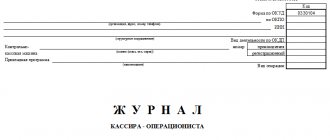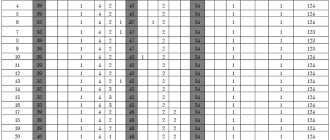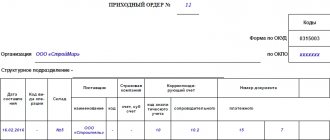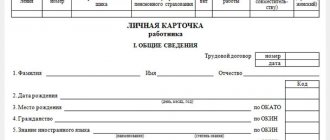Why is the KM-6 form needed?
Certificate form KM-6 is the main reporting document of the cashier. It indicates the revenue received and is handed over to the manager along with the revenue. If the proceeds are given to collectors, then a corresponding note is required in the certificate-report.
In the work of inspection bodies, such certificates play a very important role. It is on their basis that a conclusion is made about the completeness of revenue reflection. In addition, information from the KM-6 certificate is used to fill out a summary report. This report includes data on the status of cash register meters and the income of the enterprise.
Instructions for filling
The cashier's report is completed in strict accordance with the following instructions:
- In the “organization” field, enter the full name, address, contact phone number, INN and OKPO.
- In the “KKM” column, the type and model of the cash register is indicated;
- It is also necessary to indicate the cash register number in accordance with its technical passport;
- In the line “registration number” write the cash register number that was assigned to it when registering with the tax office.
- The string “application program” is intended to name the program used in the cash register.
- In the “cashier” field, indicate the initials, as well as the individual number of the cashier responsible for maintaining this cash register.
- The “shift” column is intended to indicate the current shift number.
- It is necessary to indicate the serial number of the document and the date of its execution.
- In the line “working time” indicate the exact start and end time of the work shift.
The cashier-operator certificate report table is filled out as follows:
- 1 – Z-report number;
- 2 – number of the department in which the cash register is located;
- 3 – number of the section in which the cash register is located;
- 4 – remains blank;
- 5 – balance of funds at the beginning of the working day;
- 6 – balance of money at the end of the day;
- 7 – the amount of revenue received per shift;
- 8 – amount of returned funds;
- 9 – initials of the responsible cashier;
- 10 – cashier’s signature;
- Total – total values of returned amounts and revenue.
Features of the help report
The cashier-operator's certificate-report has several characteristic features:
- the KM-6 form, approved by the State Statistics Committee of the Russian Federation in 1998, is unified;
- errors when filling out, as well as deviations from the generally accepted format, may result in a fine during the work of inspection bodies;
- KM-6 must be filled out daily (or at the end of each shift), and simultaneous filling out of certificates for 2 or more days/shifts is not allowed;
- The document must be submitted simultaneously with the proceeds - either to the chief cashier of the company or to the bank;
- The certificate must be kept for exactly 5 years, after which it loses its value.
Important! Column 4 is filled in only when using outdated cash register equipment. If modern devices have been installed in the organization over the past 12 years, then this section should be left blank.
Mandatory cash documents when working with online cash registers
Cash transactions are recorded in accordance with BR Decree No. 3210-U dated March 11, 2014. After the transition to new online cash registers, document flow was maintained. It is also necessary to draw up cash receipt orders (PKO) and cash outflow orders (COS) with the information entered in the cash book.
The forms of unified cash documents were approved by Resolution of the State Statistics Committee of the Russian Federation No. 88 back in 1998 and remain unchanged even after registration of online cash registers.
Cash book
Form No. KO-4 - cash book reflects information about received and issued funds, indicating the details of the PKO, RKO, recipient, and contributor of finance.
Photo 4. The cash book is filled out, despite the transition to online cash register
Records are kept directly on the day of the cash transaction.
You can maintain Form KO-4:
- using paper forms manually;
- on computer technology with subsequent printing;
- in electronic form.
It is allowed to make changes to cash books filled out manually. To do this, the erroneous entry is crossed out and the correct information is entered. Such corrections must be certified by the cashier or chief accountant.
Important! Changes cannot be made to electronic cash books after they have been signed.
If an enterprise has separate divisions, cash books are maintained for each of them separately.
If there are no such divisions at the enterprise, one cash book is required even when combining tax regimes.
Individual entrepreneurs have the right to draw up one form No. KO-4 when conducting cash transactions.
In the absence of appropriate entries in the cash book, fines are provided:
- in the amount of 40,000 - 50,000 rubles. to the enterprise;
- in the amount of 4,000 – 5,000 rubles. for a manager, individual entrepreneur.
Receipt cash order
Form No. KO-1 – cash receipt order (PKO) displays the receipt of cash. The form consists of two parts: the order itself and the tear-off receipt.
The cashier fills out all the lines and signs both parts of the document. You can attach a report on the closure of the shift, which is the primary document, to the “receipt”.
Reference! It is not necessary to print out the shift closing report at the online cash register and keep it.
Account cash warrant
Form No. KO-2 - cash receipt order (RKO) reflects the amounts of cash issued from the cash register.
In the context of the use of online cash registers, RKO is issued when issuing small change bills and coins to the cashier-operator.
Photo 5. Small change at the cash register
Moreover, data on the issuance of small change coins, in addition to RKO, is entered:
- in the cash book (form KO-5);
- in the book of accounting of funds issued and received by the cashier (form KO-5) if there is a senior cashier.
Important point! Making changes to incoming and outgoing orders is not allowed.
General filling rules
In order to avoid mistakes when entering information into the KM-6 form, you must follow the general rules:
The first line of the report should contain the name, address (legal or actual - it doesn’t matter, the main thing is that it is the same in all reports) and telephone number of the enterprise. If there is a separate division, then its name must also be indicated.
If the KM-6 form is filled out by an individual entrepreneur, then he must indicate all the necessary information in the same order. This is a common mistake - many individual entrepreneurs believe that they can deviate from the unified form, because they work for themselves. The document must indicate the name, registration number and number of the CCP manufacturer. You must indicate the exact date of completion and certificate number. Revenue must be reported in numerical form and in words. The signature of the author of the certificate report is a required element.
Important! If the proceeds are not handed over to the company’s chief cashier, but to the bank, then this must be noted in the report.
Certificate-report of cashier-operator (form and sample)
In small private companies, employees immediately give the completed form to bank employees. If this does not happen, the management undertakes to keep the certificate for 5 years.
The use of the KM-6 report is widespread not only in the trade sphere, but in any company that maintains accounting records of the income and expense balance. This greatly simplifies the work of the controller during the annual reconciliation of documents.
Today, this certificate is in the form recommended by the Ministry of Finance of the Russian Federation for enterprises. The company may refuse to fill out the KM-6 form, but undertakes to provide an alternative method of reporting to cashiers-operators. This is a necessity prescribed by clause 6.1 of the Standard Rules for the Operation of Cash Register Machines, which was approved by the Ministry of Finance on August 30, 1993 No. 104.
Since the state does not provide for administrative or criminal liability for the absence of the KM-6 form, the tax inspectorate cannot impose a fine on the company. But this does not exempt management and accounting from filling out and submitting an alternative cashier’s report to regulatory authorities. This can be a cash book with all the necessary entries for the receipt and expenditure of material resources. Also, the absence of the KM-6 form filled out by the cashier-operator aggravates the fate of the owner of the enterprise in court if he is brought under Article 120 of the Tax Code of the Russian Federation or under Article 15.1 of the Code of Administrative Offenses.
Sample certificate. Filling example
To learn more about the KM-6 form, download a free sample. It is in *.doc format and contains the correct form of help without factual errors or inaccuracies. This sample can be used not only to study the features of the certificate report, but also for the specific work of a cashier.
The cashier-operator's certificate-report is divided into 3 parts - line, tabular and final. For convenience, we will divide it into 3 parts and an example of filling it out so that the reader can quickly find exactly what interests him.
So, an example of entering information into the line part of KM-6:
- In the “Organization” field enter the name of the enterprise, its address, and contact telephone number.
- The identification number of the enterprise where the cashier works is entered in the TIN field.
- The “Structural division” field does not need to be touched if this division does not exist in the company.
- In the “Cash register equipment” field, information about cash register models is entered.
- In the “Number” field – the number of the cash register. This information, as well as the information for point 3, can be obtained from the senior cashier or read in the cash register documentation.
- The “Application program” field remains empty if such a program is not used.
- In the “Cashier” field, enter the cashier’s last name and initials. If a certificate is created for 2 or more sectors that have several cashiers, then the field remains empty.
- The number of the current Z-report is entered in the “Change” field. This is not shown in the sample, but it typically starts with the letter "Z". For example, "Z 0040".
Important! Next comes an intermediate field in which you need to enter the serial number of the reference report, the date of preparation, the start time of work on the report and the end time of work. These data cannot be ignored.
The tabular part of the certificate must be filled out as follows:
- Column 4 should also be left blank if modern cash register technology is used (since 2004).
- In column 5 enter the amount at the beginning of the day or shift. This amount can be found in the cashier-operator’s journal, in column 9. It was left there by the cashier who worked the previous shift. This amount is also in the morning X-report, in the GROSS TOTAL line.
- In column 6 enter the amount from the GROSS TOTAL line of the Z-report.
- In column 7 - the amount from the “Shift Total” line of the Z-report. If returns occurred during the day/shift, then you need to enter the shift total minus the returns.
- Column 8 should be left blank if there were no returns. If they were, then you need to enter the amount from the “Returns” line of the Z-report.
- In column 9, the cashier enters his last name.
- The cashier signs in column 10.
The sums of columns 7 and 8 are entered in the “Total” field.
Important! Empty columns can be crossed out. Cashiers often cross them out so that the inspection authorities know for sure that the document is completed completely and the cashier has not forgotten anything.
The final part of the certificate is completed as follows:
- The line “Total...” requires you to enter the proceeds in words.
- The line “Accepted...” should be left blank. It is necessary when a receipt order is issued for a report. In practice this rarely happens.
- The line “Delivered to the bank” contains information about the bank only if the report is handed over to the collector. If the proceeds and certificate are given to the chief cashier, then this line should be left blank.
- There is also no particular point in filling out the “Receipt No.” line, because it refers to the “Accepted...” line.
Next, you need to leave signatures and transcripts of the signatures of the operator, senior cashier and head of the enterprise.
Online cash register reports: types, concepts
The latest generation cash registers create fiscal documents and remotely send them to the Tax and Duty Inspectorate. The memory of the fiscal drive stores reports on the online cash register, which reflect:
- registration and re-registration of a cash register;
- cash register shift;
- cash receipts or strict reporting forms;
- correction of previously carried out calculations;
- replacement of the fiscal drive;
- state of settlements at a point in time;
- operator confirmation.
Printing out cash register reports and storing them on physical media are a thing of the past; nowadays everything is stored in an electronic version; let’s look at them in more detail.
- Technical support for 12 months.
6 000 ₽
6000
https://online-kassa.ru/kupit/tehnicheskoe-soprovozhdenie-na-12-mes/
OrderMore detailsIn stock
- Technical support for 3 months.
3 600 ₽
3600
https://online-kassa.ru/kupit/tehnicheskoe-soprovozhdenie-na-3-mes/
OrderMore detailsOut of stock
- Technical support for 6 months.
6 600 ₽
6600
https://online-kassa.ru/kupit/tehnicheskoe-soprovozhdenie-na-6-mes/
OrderMore detailsOut of stock
Report on registration and changes in cash register parameters
Federal Law 54-FZ regulates the mandatory registration of a cash register; before this, it is prohibited to start working on it. After registration with the Federal Tax Service, a report on the registration of the online cash register is displayed once, which displays information about the business entity, device model, installation address of the cash register (for an online store this is a web resource), and also reflects the operating mode and name of the fiscal operator data. Along with this, a serial number, a fiscal sign with the date and time of its receipt are written down.
You should remember the established time limits for submitting the report to the regulatory authority: within one working day after submission of the registration number from the Federal Tax Service. In this case, until the summary is displayed, the device cannot be used. Submitting a report is possible by directly submitting a printout to the tax service or online through a profile on the OFD page, as well as through a personal account on the official website of the Federal Tax Service. If an enterprise reports via the Internet, then the date of submission of the report is equal to the time of its publication.
If the taxpayer has changed any of the conditions that he entered when registering the device, then a report on changes in parameters is created. To do this, the values are edited in the cash register settings, indicating the reasons for the amendments, and then re-registration is carried out.
There is a way to independently correct mistakes made during CCP registration - through the above-mentioned report, but within one business day.
1. Ask our specialist a question at the end of the article. 2. Get detailed advice and a full description of the nuances! 3. Or find a ready-made answer in the comments of our readers.
Cash receipts as a type of online cash register report
A cash receipt is a fiscal document issued when making payments to customers. At the legislative level, mandatory details have been approved that are written on the check. A category of economic entities has been identified, for example, in the field of providing services to the public, which have the right to formalize their trade relations with customers through a strict reporting form. It is a legal replacement for a cash receipt.
The same law mentioned above determines the presence of basic details, while filling it out by hand or using a template printed in a printing house will soon be unacceptable. From the second half of 2021, it is allowed to use only forms printed on a special automated system.
Common mistakes when filling out
Newbie cashiers sometimes make the ridiculous mistake of entering their own TIN instead of the company’s TIN. Of course this is wrong. The identification number must always belong to the company.
Columns 5 and 6 of the main table should not be confused. Column 5 contains the GROSS TOTAL of the X-report, and column 6 - the GROSS TOTAL of the Z-report. It can't be the other way around. This mistake is often made due to inattention.
Other errors are due to inattention when entering numerical values. For example, you can confuse the date or make a mistake when entering the amount. Such errors are unacceptable, so the cashier should check everything properly.
Important! If there are typos in the KM-6 form itself, then no one will punish the cashier for them. A fine can only be issued for errors in the information that the cashier-operator personally entered.
What is a cashier's report?
The cashier needs to draw up a report every day (No. KO-4 “Cash Book”), which includes the date and sheet number of the cash book, the balance at the beginning of the day, cash order numbers, counterparties or employees, the corresponding account number and the amount in figures. The cashier crosses out the empty lines of the report with the letter Z, indicates the number of orders in words and displays the cash balance.
The final amount received is checked by an authorized employee with the actual cash balance. Next, the cashier signs the report and submits it to the accountant for verification. If there were no transactions during the day, then there is no need to prepare a cashier’s report. If the organization employs several cashiers, the senior cashier fills out the accounting book (No. KO-5) when transferring money to him.
The process of preparing a cash report:
- The receipt orders are applied first in order;
- Then expense orders, with supporting documents, for example, an application for reporting, a payroll statement for the payment of wages, etc.;
- Next, the documents are stitched.









